Appliances
Can a Toilet Freeze in Cold Weather
2025
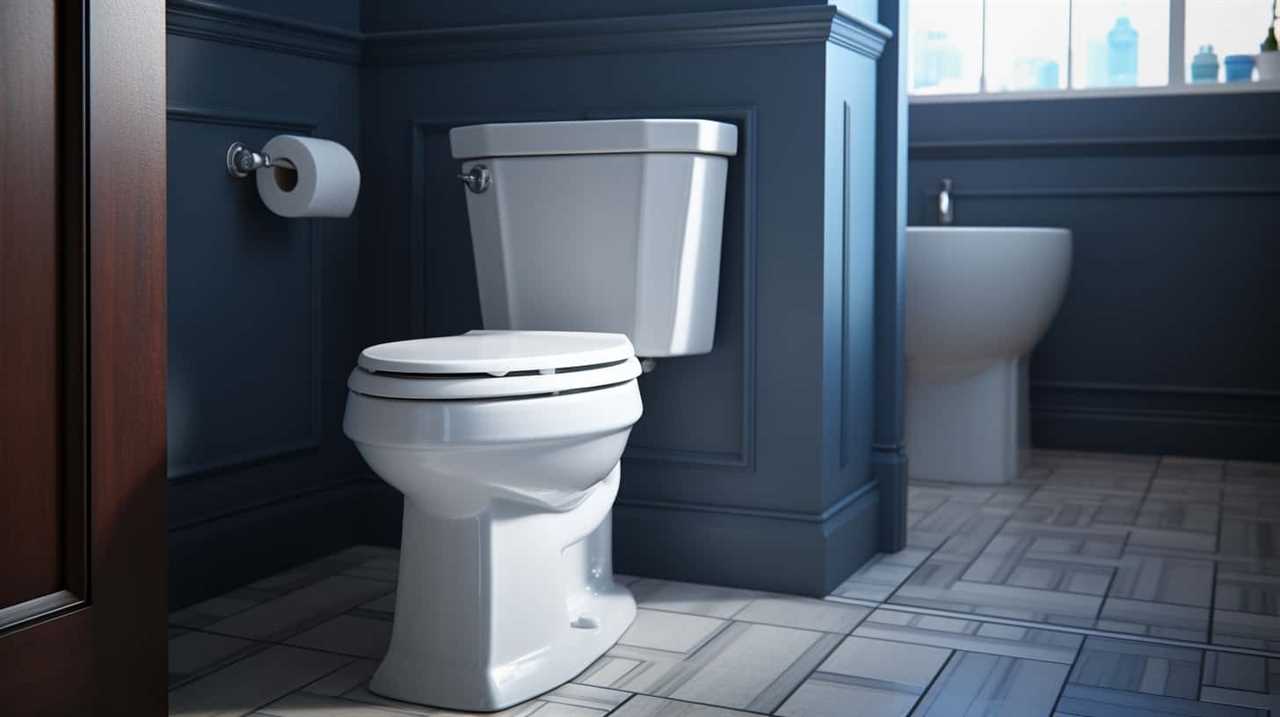
If you’ve ever wondered whether a toilet can freeze in cold weather, we’ve got the answers you need.
In this article, we’ll explore the science behind toilet freezing, the risks it poses, and how to protect your plumbing system.
Frozen toilets can lead to serious damages and inconveniences, but with the right knowledge and precautions, you can prevent them.
So grab a cup of coffee, and let’s dive into the fascinating world of frozen toilets.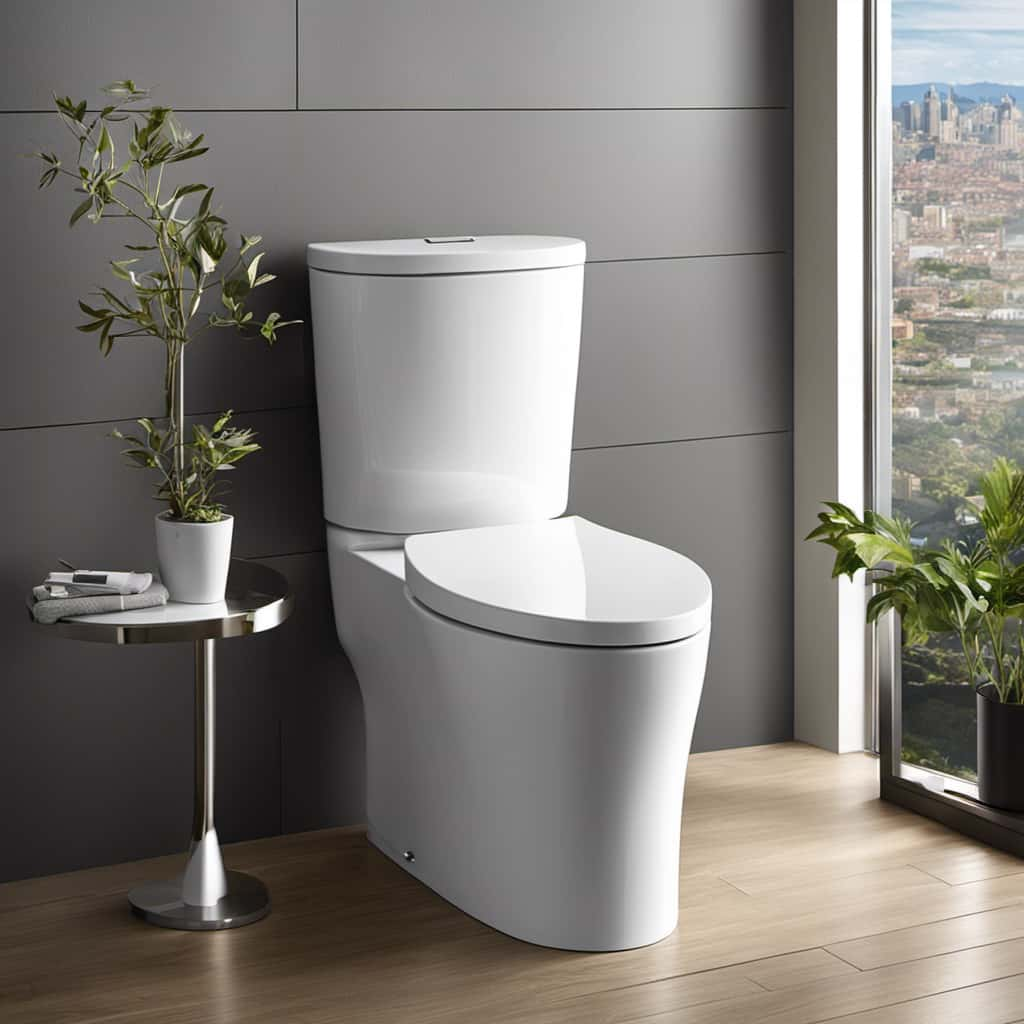
Key Takeaways
- Insulating the water supply line and keeping the temperature above freezing can prevent frozen toilets.
- Opening cabinet doors and allowing a small trickle of water to flow through the pipes can help prevent freezing.
- Frozen toilets can lead to burst pipes, cracked toilets, clogged drains, and water damage.
- Preventive measures such as insulating pipes, keeping the toilet warm, and regular winter plumbing maintenance are crucial to avoid expensive repairs.
Common Concerns: Can a Toilet Freeze
One common concern people have during cold weather is whether a toilet can freeze. Fortunately, there are preventive measures and winter maintenance practices that can help avoid this issue.
To prevent a toilet from freezing, it’s crucial to insulate the water supply line. This can be done by wrapping it with insulating material or using heat tape. Additionally, keeping the temperature in your home above freezing will help maintain a warm environment for your toilet and prevent freezing.
Regular winter toilet maintenance is also necessary to prevent freezing. Checking for any leaks or cracks in the toilet tank and bowl is important, as these can lead to frozen pipes and subsequent damage. Insulating the tank and bowl with foam insulation will provide added protection against freezing.
Furthermore, it’s recommended to keep the bathroom door closed during colder periods to maintain a warmer temperature in the room. This will help prevent the toilet from freezing.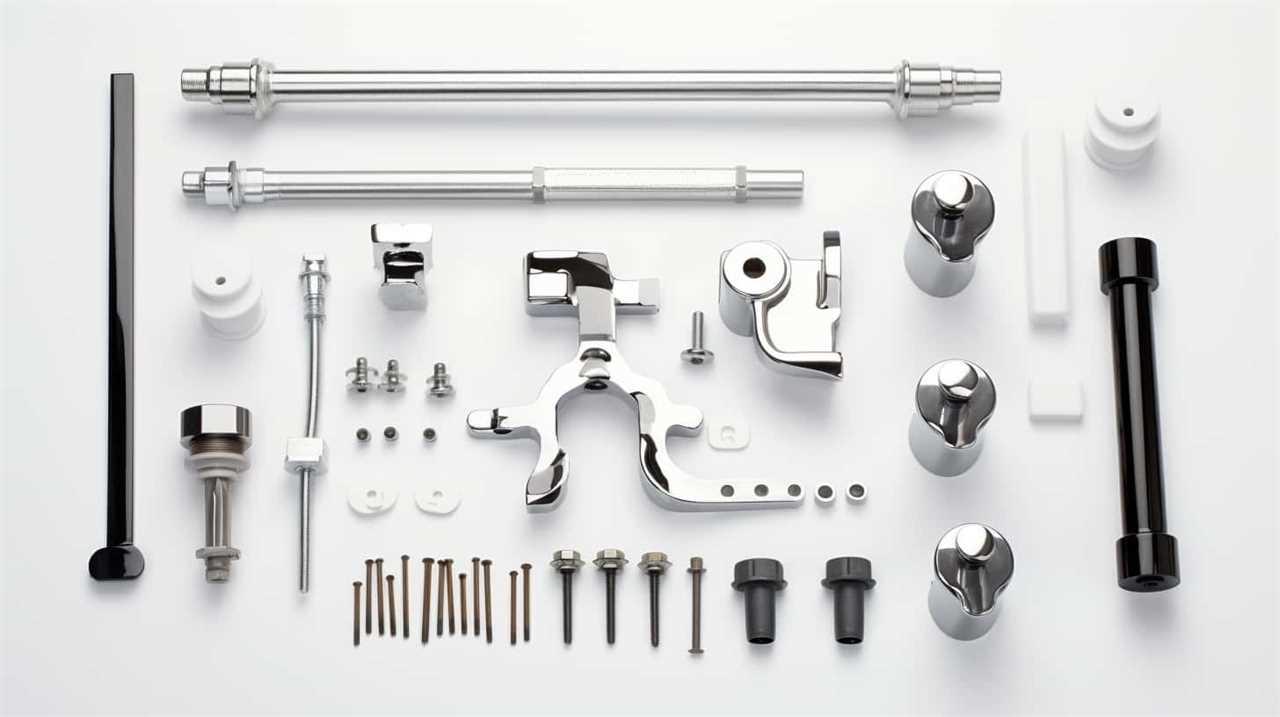
The Science Behind Toilet Freezing
To understand the science behind toilet freezing, let’s delve into the factors that contribute to this phenomenon during cold weather.
When temperatures drop, the physics behind toilet freezing can be explained by a few key principles. One of the primary factors is the presence of water in the pipes. Water expands when it freezes, and this expansion can lead to the pipes cracking or bursting. Additionally, the temperature of the surrounding air plays a crucial role. If the air temperature drops below freezing, the water in the pipes can freeze, causing blockages and preventing the toilet from flushing properly.
Preventing frozen pipes requires taking certain measures. Insulating the pipes is one effective method. This can be done by wrapping them with foam or installing heat tape. Keeping the temperature inside the house above freezing can also help. Opening cabinet doors to allow warm air to reach the pipes is another useful strategy. Moreover, allowing a small trickle of water to flow through the pipes can help prevent freezing. Moving water is less likely to freeze compared to stagnant water.
Understanding the physics behind toilet freezing and implementing preventative measures can help ensure that toilets remain functional during cold weather. By taking these precautions, homeowners can avoid the inconvenience and expense of dealing with frozen pipes.
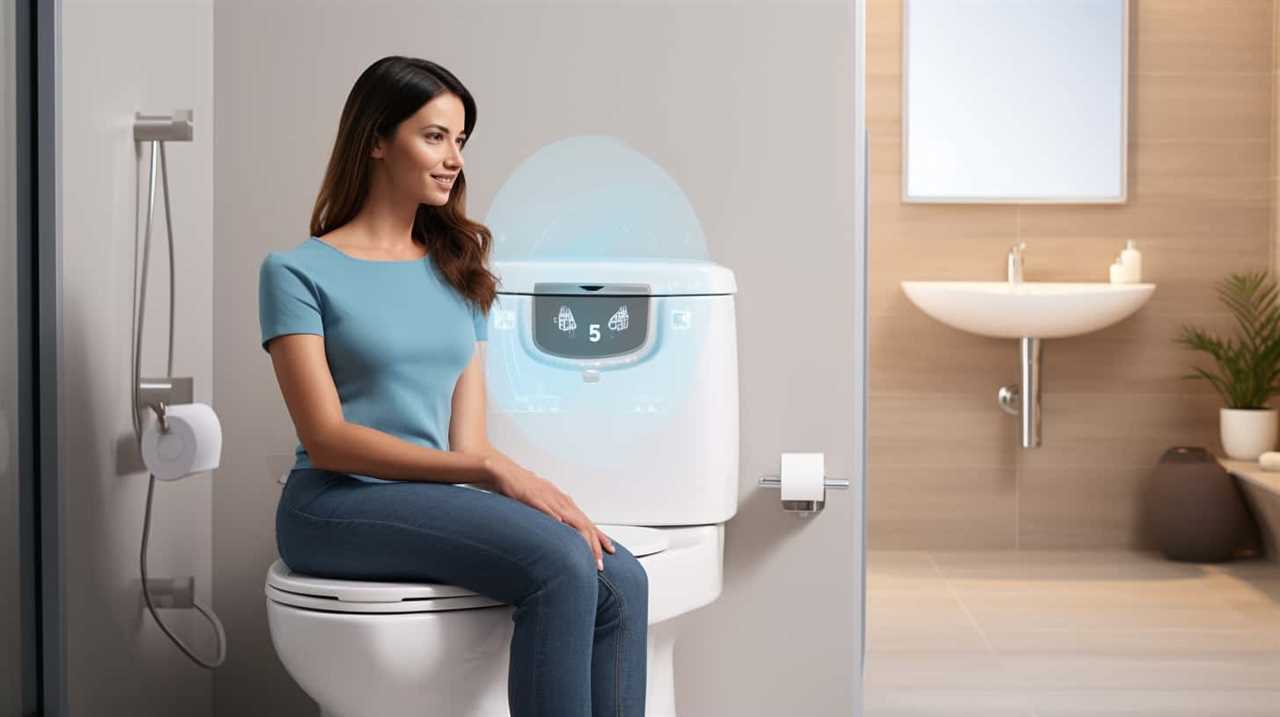
Understanding the Risks of Frozen Toilets
Now, let’s explore the risks of frozen toilets that homeowners may encounter during cold weather. It’s essential to understand the potential issues that can arise when toilets freeze, as they can lead to costly repairs and inconvenience. Here are three key risks to be aware of:
- Burst pipes: When water freezes inside the toilet’s plumbing system, the expanding ice can put significant pressure on the pipes. This pressure increases the chances of pipes bursting, resulting in water leaks and potential water damage to your home. To prevent frozen pipes, insulating them with pipe sleeves or heat tape can be effective.
- Cracked toilet bowl: The extreme cold temperatures can cause the porcelain toilet bowl to contract, making it more susceptible to cracking or breaking. A cracked toilet bowl not only leads to leakage but also requires a complete replacement, which can be both expensive and time-consuming.
- Clogged drains: Freezing temperatures can cause the water in the drains to freeze, leading to blockages and clogged pipes. This can prevent proper flushing and cause wastewater backups. Regular winter plumbing maintenance, such as using drain de-icer or insulating exposed pipes, can help prevent clogged drains.
Understanding these risks underscores the importance of taking preventive measures to avoid frozen toilets. By implementing proper winter plumbing maintenance and taking precautions to prevent frozen pipes, you can mitigate the risks and ensure a smoothly functioning toilet during cold weather.
Next, let’s delve into the potential damages caused by frozen toilets.
Potential Damages Caused by Frozen Toilets
When a toilet freezes, it can lead to potential damages that can be costly to repair. The freezing of water in the pipes can cause them to crack or burst, resulting in water leaks and flooding.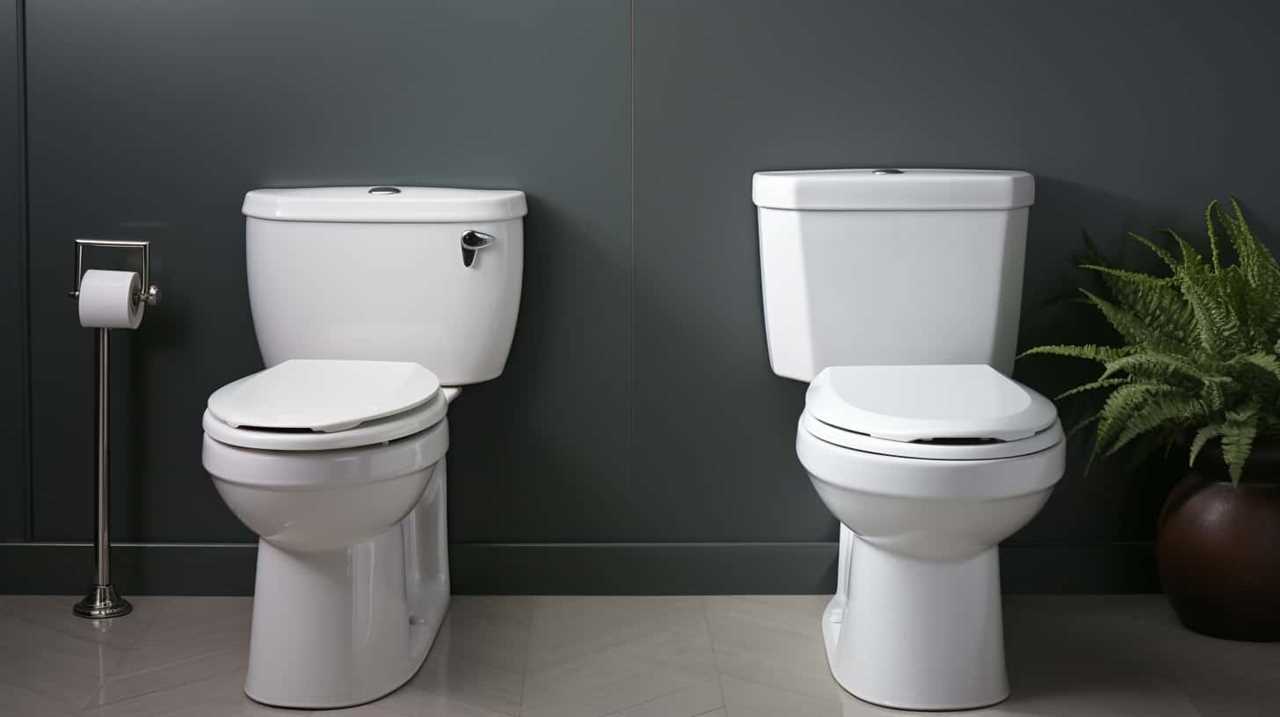
Additionally, the expansion of frozen water can also damage the internal components of the toilet, requiring replacement or repair.
To prevent these damages, it’s important to take preventive measures such as insulating pipes and keeping the toilet warm during cold weather.
Plumbing Repair Costs
We frequently encounter potential damages caused by frozen toilets, and the costs of plumbing repairs can quickly add up. When a toilet freezes, it can lead to a range of issues that require professional assistance.
Here are some common plumbing repair costs associated with frozen toilets:
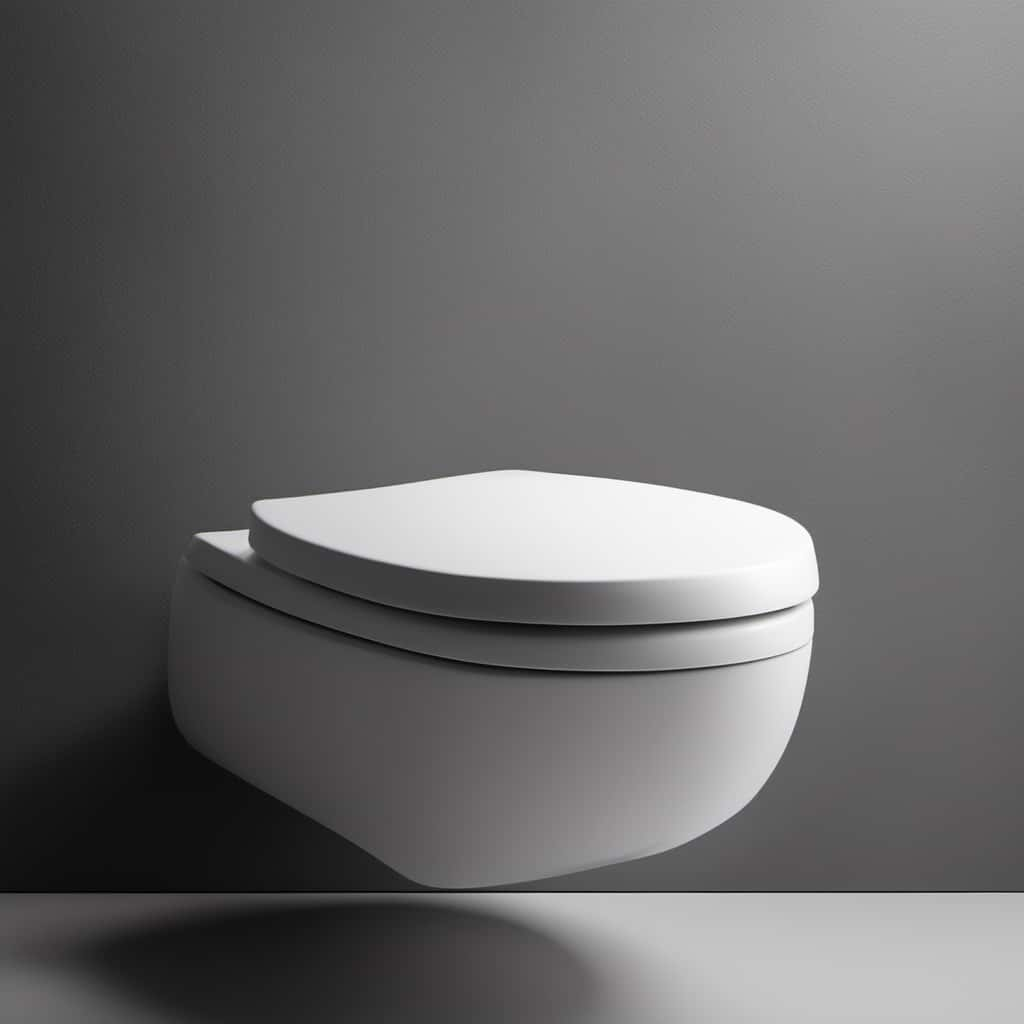
- Pipe bursts: Frozen water expands and can cause pipes to burst, leading to water damage and costly repairs.
- Toilet replacement: In severe cases, a frozen toilet may crack or break, necessitating the installation of a new toilet.
- Water damage remediation: Thawing a frozen toilet can result in water leakage, leading to water damage that requires professional cleanup and restoration.
To prevent these plumbing repair costs, it’s crucial to take preventive measures such as insulating pipes, keeping the toilet warm, and allowing faucets to drip during freezing temperatures.
Preventing Frozen Toilets
To prevent potential damages caused by frozen toilets, there are a few toilet freeze prevention techniques that can help us avoid the inconvenience and expense of dealing with a frozen toilet.
One common cause of toilet freezing is cold air reaching the pipes. Insulating the pipes using foam pipe insulation can help prevent this.
Another cause is a lack of heat in the bathroom. Keeping the bathroom temperature above freezing by using a space heater or leaving the door open can help prevent freezing.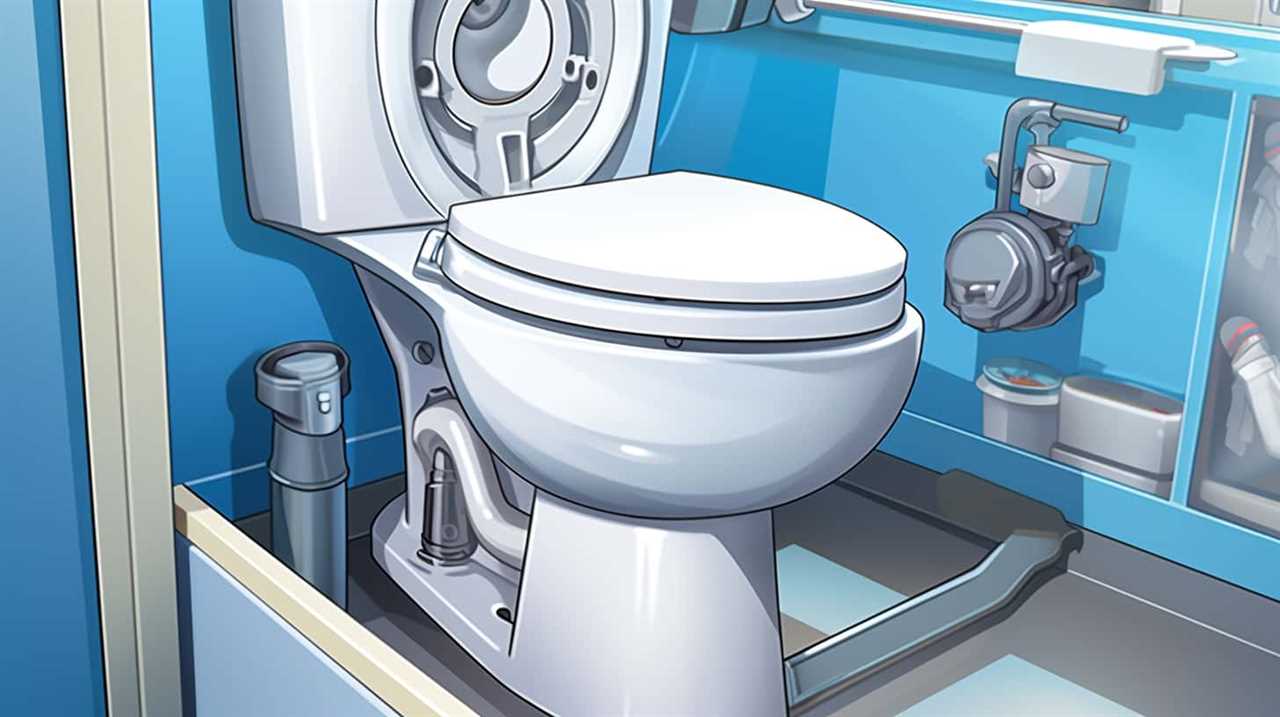
Additionally, leaving the faucet dripping can relieve pressure and prevent water from freezing in the pipes.
Signs and Symptoms of a Frozen Toilet
One common sign of a frozen toilet is water backing up into the bowl. When the water freezes, it expands and can block the pipes, causing the water to have nowhere to go but back into the toilet bowl. This is often accompanied by a gurgling sound as the water tries to find an escape route.
Other signs and symptoms include:
- Slow or no draining: A frozen toilet may have difficulty draining properly or may not drain at all. This can be due to ice blocking the pipes, preventing the water from flowing through.
- Ice buildup: In severe cases, you may visually notice ice buildup around the base of the toilet or even inside the bowl itself. This is a clear indication that the toilet has frozen.
- Lack of water supply: If your toilet is frozen, you may also experience a lack of water supply when trying to flush. This is because the water in the pipes leading to the toilet may have frozen, preventing the flow of water.
To prevent toilet freezing, it’s important to insulate exposed pipes, especially those in colder areas of your home. This can be done using pipe insulation or heat tape. Additionally, keeping the temperature in your home above freezing and opening cabinet doors to allow warm air to circulate around the pipes can help prevent freezing.
Prevention Tips to Keep Your Toilet From Freezing
To prevent your toilet from freezing in cold weather, there are a few key steps you can take.
First, make sure to properly insulate the toilet tank. This can help retain heat and prevent freezing.
Additionally, consider using a tank heater device, which can provide additional warmth to the tank and prevent freezing.
Insulating Toilet Tank Properly
We can prevent our toilet tank from freezing by properly insulating it. Insulating the toilet tank helps maintain a consistent temperature, preventing condensation and freezing.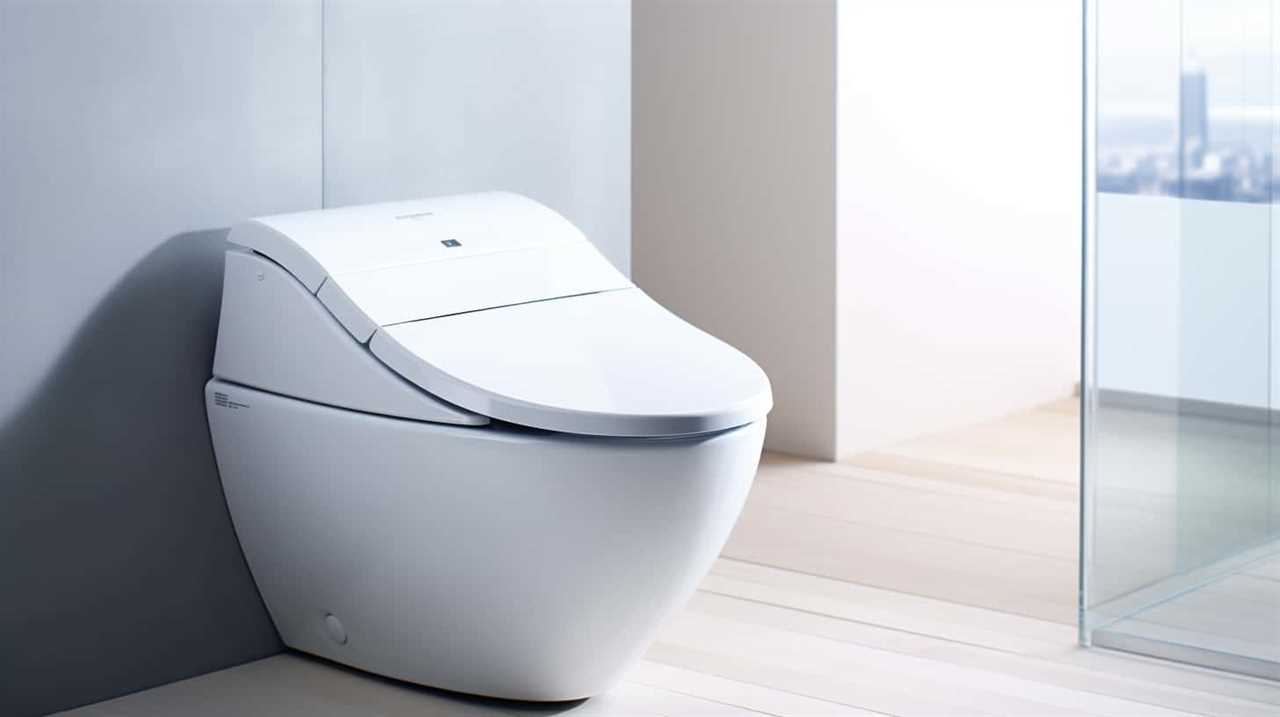
Here are three important tips to ensure proper insulation:
- Use insulation materials: Wrap the toilet tank with insulation materials, such as foam or insulating tape. These materials provide a barrier against cold temperatures and help retain heat inside the tank.
- Insulate the water supply line: Insulate the water supply line leading to the toilet tank to prevent freezing. Use pipe insulation sleeves or heat tape to cover the exposed sections of the supply line.
- Seal gaps and cracks: Inspect the toilet tank for any gaps or cracks that may allow cold air to enter. Use caulk or sealant to seal these openings and prevent heat loss.
Using Tank Heater Device
To further protect our toilet tank from freezing, let’s explore the option of using a tank heater device. Installing a tank heater is a reliable solution to prevent freezing in extremely cold weather conditions. These devices are designed to keep the water in the tank at a consistent temperature, ensuring it doesn’t freeze.
The installation process is relatively straightforward and can be done by following the manufacturer’s instructions. Tank heater devices come in different models and sizes, so it’s important to choose one that’s compatible with your toilet tank.
Additionally, it’s essential to consider alternative solutions, such as insulating the toilet tank, to provide an extra layer of protection against freezing temperatures.
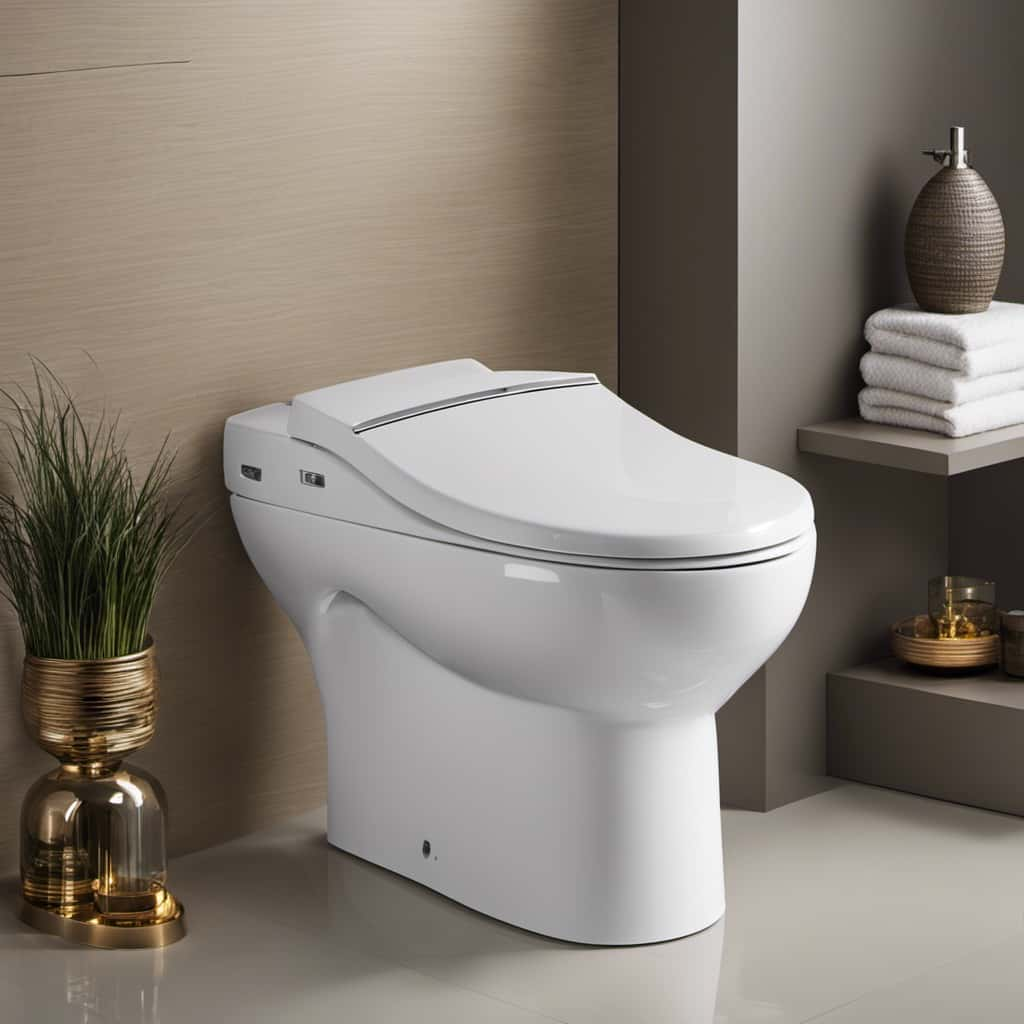
Now, let’s move on to the next section, where we’ll provide a step-by-step guide on insulating your toilet tank.
Insulating Your Toilet Tank: A Step-by-Step Guide
Our first step in insulating the toilet tank is to gather the necessary materials and tools. Here is what you’ll need:
- Insulating foam tape: This tape is designed to create a thermal barrier and prevent heat loss from the tank. It’s easy to apply and provides effective insulation.
- Insulating jacket or blanket: These specially designed jackets or blankets are made of insulating materials such as fiberglass or foam. They wrap around the tank and provide an additional layer of insulation.
- Adhesive or fasteners: You’ll need adhesive or fasteners to secure the insulating materials to the tank. Make sure to choose a strong adhesive or sturdy fasteners that can withstand the temperature and moisture levels in the bathroom.
Now that you have gathered the necessary materials and tools, let’s move on to the next step: applying the insulation.
Protecting Your Toilet Pipes From Freezing
To prevent freezing and potential damage to your toilet pipes, it’s essential to take additional measures beyond insulating the tank. Preventing frozen pipes is a crucial aspect of winter plumbing maintenance that requires careful attention.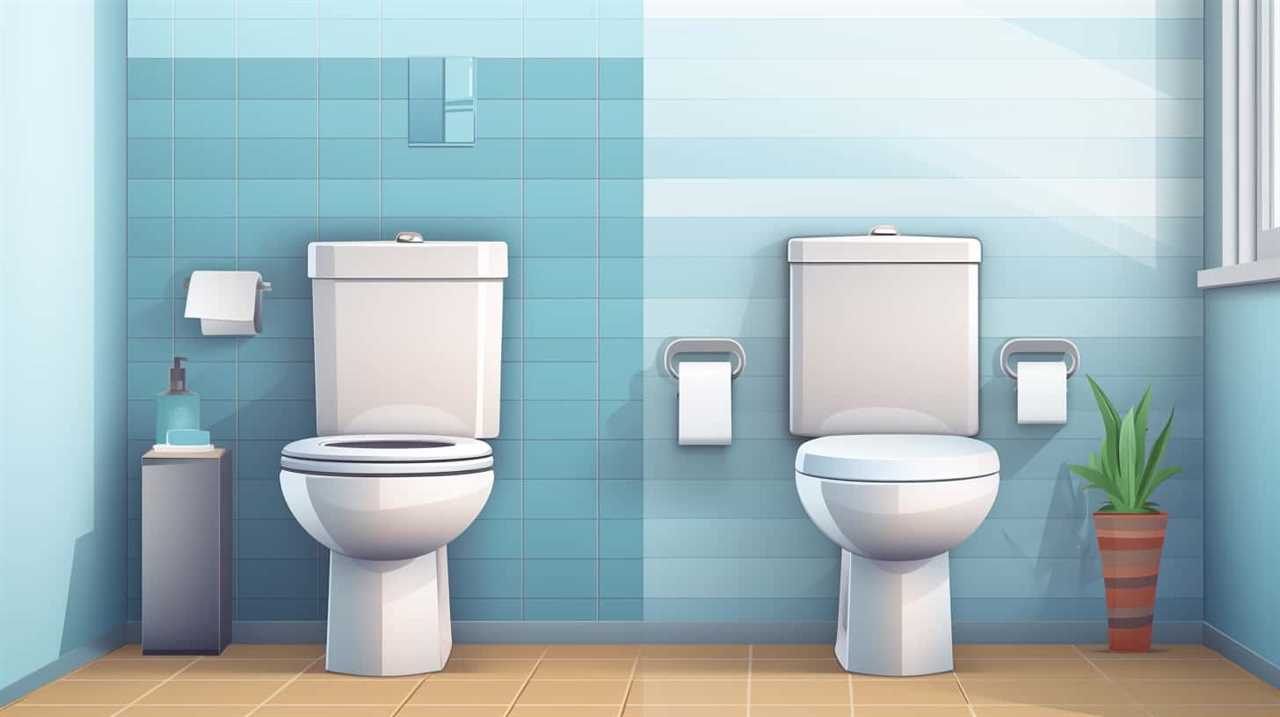
One effective method is to ensure that the area where the water supply line enters your home is well-insulated. This can be achieved by using insulation sleeves or heat tape specifically designed for pipes.
Additionally, it’s important to seal any gaps or cracks in the walls or foundation near the pipes to prevent cold air from seeping in. Another preventive measure is to keep the cabinet doors under your sink open, allowing warm air to circulate around the pipes.
Insulating exposed pipes in unheated areas like basements or crawl spaces is also crucial. Lastly, consider installing a pipe-warming system that uses electric heat cables to keep the pipes warm during freezing temperatures.
By taking these steps, you can significantly reduce the risk of frozen pipes and ensure the smooth functioning of your toilet.

Now, let’s move on to discussing the use of heat sources to keep your toilet warm.
Using Heat Sources to Keep Your Toilet Warm
We can keep our toilet warm by utilizing various heat sources. Here are three options to consider:
- Heated toilet seat: Installing a heated toilet seat is a convenient and effective way to keep your toilet warm. These seats are equipped with heating elements that provide a gentle and consistent source of heat. They’re usually controlled by a thermostat and can be adjusted to your desired temperature.
- Heated toilet tank: Another option is to use a heated toilet tank. These tanks are designed with built-in heating elements that keep the water inside at a constant temperature. This helps prevent freezing and ensures that the toilet is always ready for use.
- Space heater: In colder climates, using a small space heater in the bathroom can help keep the entire area warm, including the toilet. Place the heater in a safe location, away from any water sources, and set it to a comfortable temperature. This will provide additional warmth and prevent freezing.
By using these heat sources, we can effectively maintain a warm toilet and prevent freezing during cold weather. However, it’s important to note that heat sources alone may not be sufficient. Proper toilet insulation is also crucial in ensuring the overall warmth and functionality of the toilet.
Now let’s transition into the next section, which will discuss how to winterize your entire plumbing system.
Winterizing Your Entire Plumbing System
To ensure the proper functioning of our plumbing system during the cold weather, it’s important to take steps to winterize it. Winterizing pipes is crucial in preventing frozen pipes and the potential damage they can cause. Frozen pipes can burst, leading to costly repairs and water damage. Here are some key steps to winterize your entire plumbing system and avoid such issues.
Firstly, insulate exposed pipes in unheated areas such as basements, crawl spaces, and attics. This can be done using pipe insulation sleeves or heat tape. It’s also important to seal any gaps or cracks in your home’s exterior to prevent cold air from reaching the pipes.
Next, disconnect and drain outdoor hoses, faucets, and sprinkler systems. Shut off the water supply to these outdoor fixtures and drain any remaining water to prevent freezing.
Additionally, you should keep your home heated to a consistent temperature, even when you’re away. Set your thermostat to a minimum of 55°F (12°C) to ensure the pipes remain above freezing.
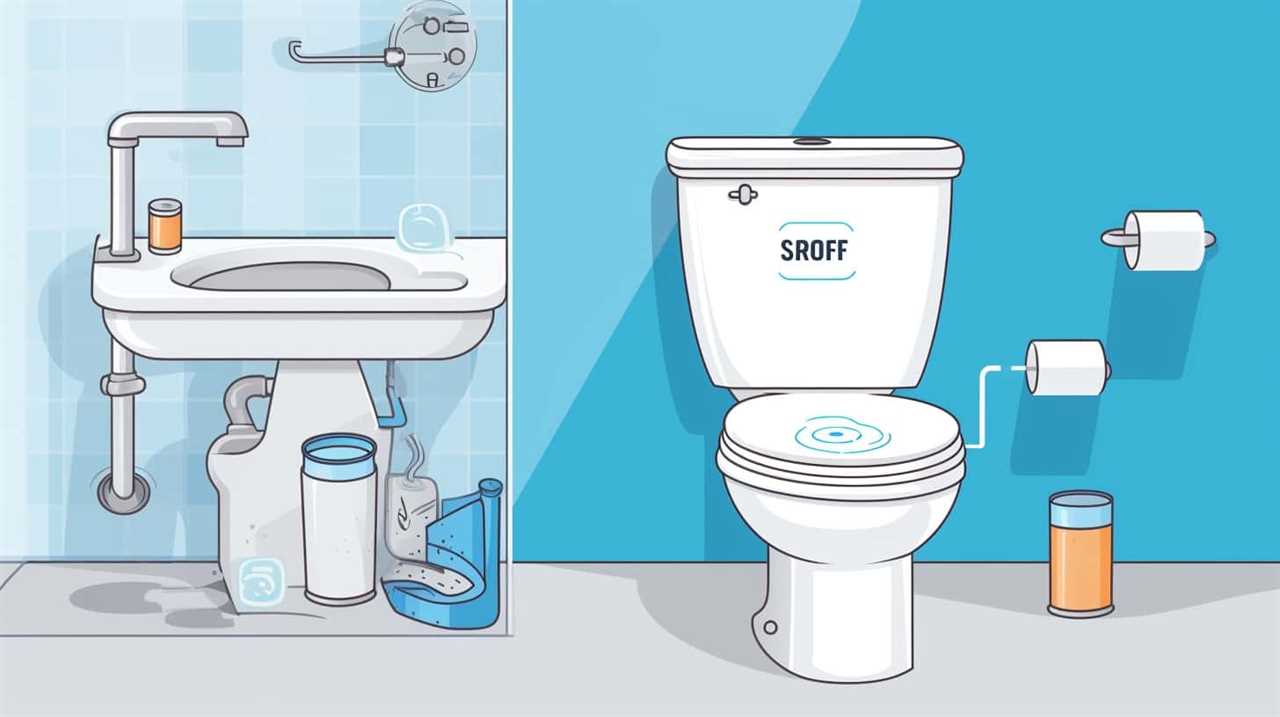
Lastly, locate and shut off the main water supply valve in case of extreme cold weather or if you plan to be away for an extended period. This will prevent water from flowing through the pipes and reduce the risk of frozen pipes.
Troubleshooting: What to Do If Your Toilet Freezes
Now that we’ve covered how to winterize your plumbing system, let’s move on to troubleshooting what to do if your toilet freezes.
There are a few steps you can take to prevent a frozen toilet, such as insulating the tank and pipes, keeping the bathroom door closed, and leaving the heat on in your home.
If your toilet does freeze, you can try thawing it with hot water or a hairdryer, but be cautious not to use excessive heat.
If these methods don’t work, it’s best to call a professional plumber to avoid causing further damage.
Preventing Toilet Freeze
To prevent toilet freeze in cold weather, homeowners should take the following key steps for effective prevention:
- Insulate pipes: Use insulating methods such as foam pipe insulation or heat tape to protect exposed pipes from freezing temperatures. This will help maintain the warmth of the water flowing through the pipes and prevent them from freezing.
- Seal air leaks: Check for any gaps or cracks near the pipes and seal them properly. This will prevent cold air from entering and causing the pipes to freeze.
- Maintain consistent temperature: Adjust the thermostat in your home to ensure a consistent temperature throughout. Keep it above freezing to prevent any freezing issues with the toilet and other plumbing fixtures.
Thawing Frozen Toilets
After insulating our pipes and maintaining a consistent temperature, we may still encounter a frozen toilet and need to know how to thaw it. Fortunately, there are several thawing methods and DIY solutions that can help resolve this issue. Here are some effective techniques to thaw a frozen toilet:
| Thawing Method | DIY Solution |
|---|---|
| Hot water | Pour hot water into the toilet bowl to melt the ice. |
| Heating pad | Place a heating pad on the base of the toilet. |
| Hairdryer | Use a hairdryer on the lowest setting to warm the pipes. |
| Heat lamp | Position a heat lamp near the frozen area. |
| Salt and hot water | Mix salt with hot water and pour it down the toilet. |
Calling a Professional
If our attempts to thaw a frozen toilet using DIY solutions are unsuccessful, we may need to consider calling a professional for assistance. While it may be tempting to try and fix the issue ourselves, calling professionals who specialize in plumbing can save us time, money, and potential damage to our plumbing system.
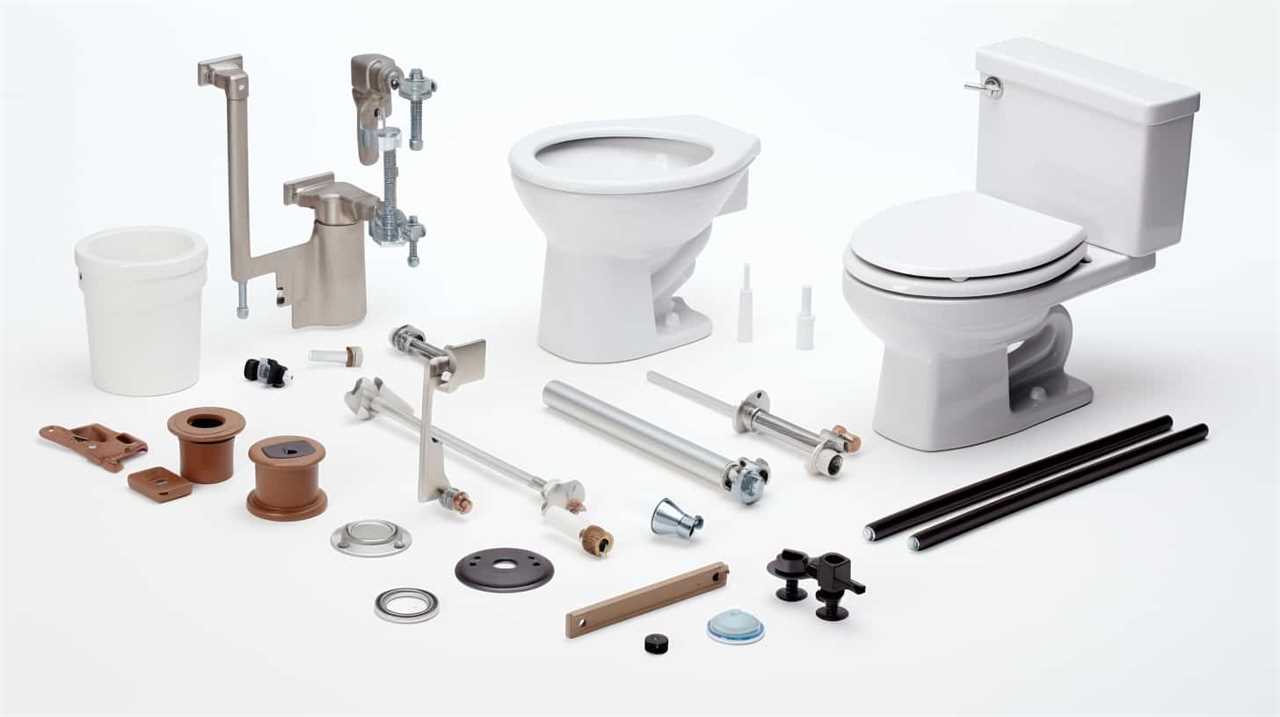
Here are three reasons why calling a professional is the best course of action:
- Expertise: Professional plumbers have the knowledge and experience to diagnose and resolve complex plumbing issues, including frozen toilets. They’re trained to identify the root cause of the problem and provide effective solutions.
- Proper Equipment: Professionals have access to specialized tools and equipment that are necessary for thawing a frozen toilet safely and efficiently. They can use techniques such as heat guns or pipe thawing machines, ensuring the job is done correctly.
- Cost Considerations: While professional assistance may incur a cost, it’s often a wise investment. Attempting to thaw a frozen toilet without the necessary skills and tools can lead to further damage, resulting in higher repair costs in the long run.
Calling a professional when our DIY attempts fail can provide us with peace of mind, knowing that our frozen toilet will be handled by experts who can efficiently thaw it while minimizing any potential damage and cost.
Frequently Asked Questions
How Does Freezing Weather Affect the Flushing Mechanism of a Toilet?
Freezing weather can have a significant impact on the flushing mechanism of a toilet. When the temperature drops, the water inside the toilet tank and pipes can freeze, causing blockages and preventing the toilet from flushing properly. This can be caused by inadequate insulation or exposure to extreme cold temperatures.
To prevent toilet bowl freezing, it’s important to insulate pipes, use heat tape, and keep the toilet lid closed. Regularly checking for leaks and ensuring proper insulation can help avoid freezing issues.
Can a Frozen Toilet Cause Damage to Other Plumbing Fixtures in the House?
A frozen toilet can indeed cause damages to other plumbing fixtures in the house. When the toilet freezes, the water inside expands, which can lead to cracked pipes or even burst water lines.
To prevent such damages, it’s important to take preventive measures such as insulating the toilet tank and pipes, keeping the room temperature above freezing, and allowing faucets to drip to keep water flowing.
These simple steps can save you from costly repairs and inconvenience.
Are There Any Signs or Symptoms That Indicate a Toilet Is Starting to Freeze?
When it comes to toilet freezing prevention, it’s essential to be aware of the signs that indicate a toilet is starting to freeze. These signs can include:
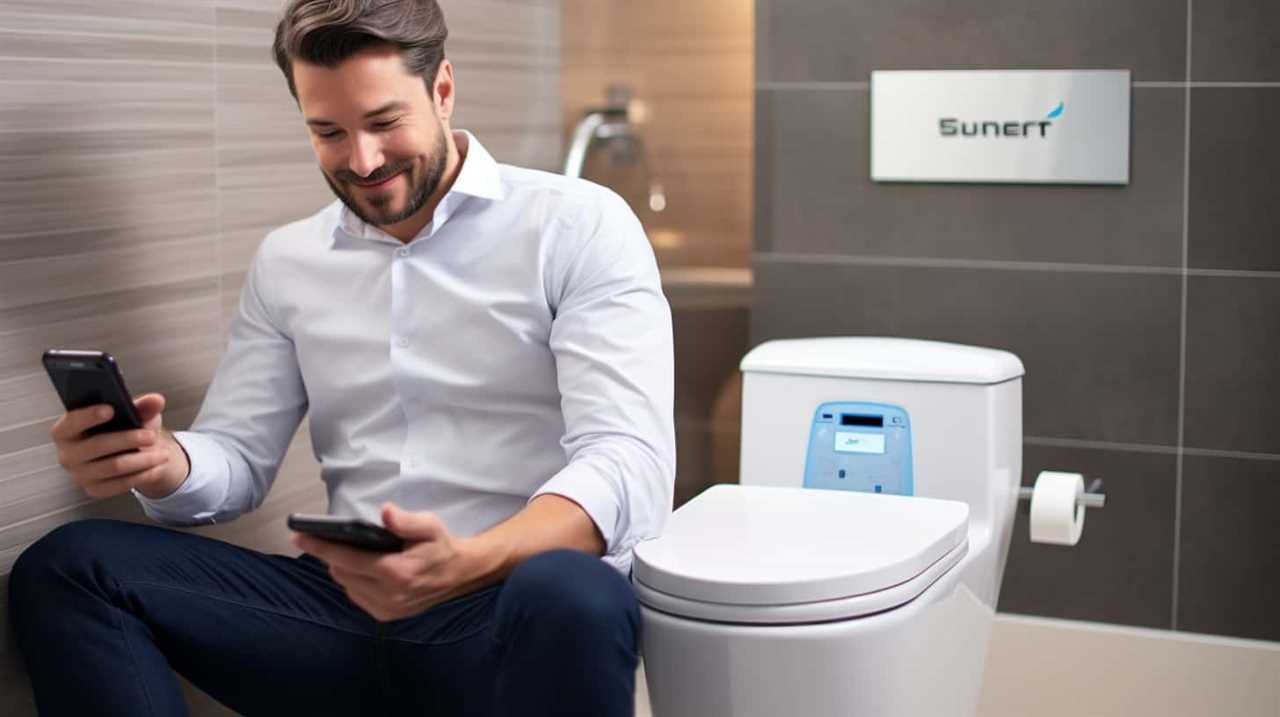
- A decrease in water flow or complete lack of water in the toilet bowl.
- A gurgling sound when flushing.
- A foul odor coming from the toilet.
Can Insulating the Toilet Tank Alone Prevent the Toilet From Freezing?
Insulating the toilet tank alone may not be sufficient to prevent freezing in extremely cold weather. We learned this when a family in a northern region insulated their toilet tank but still experienced freezing.
To fully protect your toilet, it’s essential to insulate the entire system, including the pipes and bowl. Additionally, alternative solutions such as using heat tape or installing a heating element can provide extra protection against freezing.
It’s crucial to consider these insulating methods and alternative solutions for optimal winter toilet maintenance.
Is It Necessary to Winterize the Entire Plumbing System if the Toilet Is the Only Concern?
Winterizing strategies are crucial to prevent a toilet freeze. While insulating the toilet tank alone may help, it’s necessary to winterize the entire plumbing system if the toilet is the only concern. Freezing temperatures can cause pipes to burst, leading to costly repairs.
Can Freezing Temperatures Cause Toilet Bugs to become Active in Cold Weather?
Yes, freezing temperatures can cause bugs in toilet dangers to become more active in cold weather. This is because the cold weather can drive insects and pests to seek warmth and shelter, leading them to find their way into bathrooms and toilets. It’s important to be vigilant and take preventive measures to keep these bugs at bay.
Conclusion
In conclusion, freezing temperatures can indeed cause a toilet to freeze, leading to potential damages and inconvenience.
It’s essential to understand the risks and take necessary precautions to protect your toilet pipes from freezing.
By using heat sources, winterizing your plumbing system, and being aware of the signs and symptoms of a frozen toilet, you can prevent this issue.
Remember, a frozen toilet is like a clogged pathway, halting the smooth flow of your plumbing system.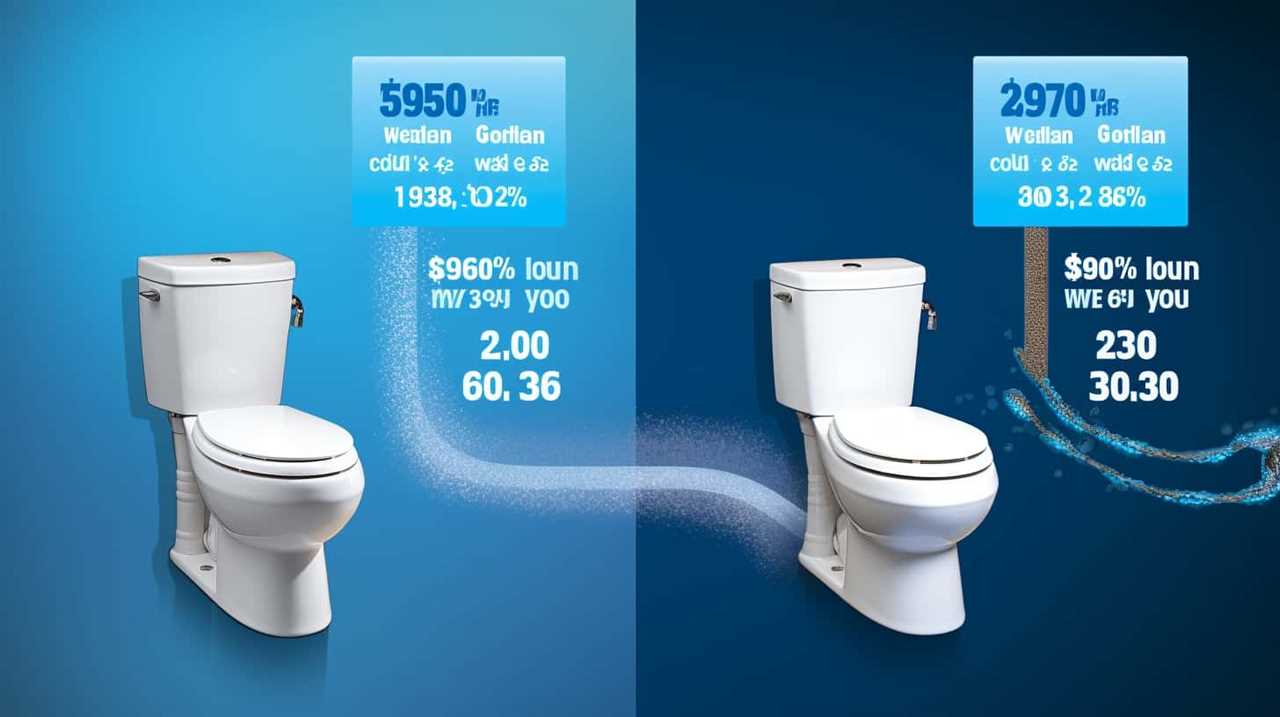
- About the Author
- Latest Posts
Introducing Charles, the Editor in Chief at ByRetreat, whose passion for interior design and editorial excellence elevates every remote workspace to new heights. With his keen eye for detail, impeccable taste, and expertise in design, Charles brings a wealth of knowledge and creativity to the ByRetreat team.
As the Editor in Chief of a renowned lifestyle blog, Charles has honed his skills in curating captivating content and staying up-to-date with the latest trends in interior design. His deep understanding of aesthetics and the power of storytelling through design enables him to create remote workspaces that are not only visually stunning but also rich in personality and meaning.
Garage Door Opener
Reset Your Liftmaster Garage Door Opener After Power Outage: 3 Easy Steps
Unravel the secrets to effortlessly resetting your Liftmaster garage door opener after a power outage in just three easy steps.

Let’s address the task of resetting your Liftmaster garage door opener after a power outage with three simple steps. Power outages can disrupt your opener’s programming, but don’t worry, resetting it is possible.
Curious to discover the secrets to regaining control of your garage door opener effortlessly? Stay tuned as we unravel the simple yet effective methods to restore your opener's functionality post-power disruption.
Key Takeaways
- Disconnect the opener, use the emergency release cord, and reattach after power outage for proper functioning.
- Test the opener post-reset to ensure remote and smart device controls work correctly.
- Follow reset steps efficiently to avoid unexpected door openings and maintain garage door functionality.
- Consider preventive measures like backup power sources and regular maintenance to prevent future outages and ensure smooth operation.
Power Outage Impact on Opener
During power outages, Liftmaster garage door openers may lose their settings, requiring manual reconnection for proper functionality. When a power outage occurs, the Liftmaster opener relies on electricity to operate and may disconnect, affecting the garage door's automatic functions.
To address this, it's essential to disconnect the opener from the door manually. Start by locating the emergency release cord, typically hanging from the opener rail. Pull down on the cord to disconnect the opener from the door, enabling manual operation.
After the power is restored, reconnect the opener by guiding the door back into place and pulling the emergency release cord towards the motor. This action will engage the opener back with the door.
Following these proper steps ensures that the Liftmaster garage door opener resumes its normal functioning after a power outage. By promptly addressing the impact of power outages, you can maintain smooth operation of your garage door system.
Resetting the Garage Door Opener

After addressing the impact of a power outage on a Liftmaster garage door opener, the next crucial step is resetting the opener to restore its functionality efficiently.
To Reset Your Garage Door opener, begin by disconnecting it from the door by unplugging it. Then, locate the emergency release cord and pull it to manually open the garage door fully. Ensure the door is closed manually once power is restored before attempting to close it using the opener again. If necessary, reattach the garage door trolley to the opener to guarantee proper operation.
This process is essential in Garage Door Repair to ensure that the opener is synchronized with the door. By following these steps, you can successfully reset your garage door opener after a power outage, allowing you to regain control over your garage door's functionality promptly.
Testing the Reset Opener
To confirm the successful reset of your Liftmaster garage door opener, press the remote-control button and observe the garage door's response. After resetting, pressing the remote-control button shouldn't result in the garage door opening unexpectedly.
It's essential to check that any smart devices previously linked to the opener are also unable to open the garage door post-reset. This step in testing the reset opener ensures that the reprogramming process was effective.
If the garage door still opens unexpectedly after the reset, consult the owner's manual for troubleshooting steps specific to your make and model. Additionally, consider reaching out to a professional for further assistance if needed.
Frequently Asked Questions
How Do I Reset My Liftmaster Garage Door After Power Outage?
When power goes out, we disengage the opener from the door by pulling the emergency release cord. After manually closing the door, we're ready for reconnection.
Once power is restored, we press the button on the opener to close the door. If necessary, we manually reattach the trolley to the carriage for proper functionality.
These steps ensure a safe and effective reset of our Liftmaster garage door opener after a power outage.
How Do I Reset My Liftmaster Garage Door Opener?
When resetting your Liftmaster garage door opener, find the 'Learn' button on the motor unit. Hold down this button for about 6 seconds until the adjacent LED light goes off. This action erases all stored remote-control and keyless entry codes.
Following the reset, reprogram your remotes and keypads to reconnect with the opener. By completing these steps, you can restore your Liftmaster garage door opener's functionality after a power outage.
How Do I Manually Reset My Garage Door Opener?
When manually resetting a garage door opener, we first locate the emergency release cord and disconnect the opener from the door.
Then, we manually operate the door to the desired position.
After power is restored, we re-engage the opener by pulling the release cord towards the door.
It's crucial to ensure the door is fully closed before reconnecting it to the opener for automatic operation.
How Do I Restore the Power to My Garage Door?
When power goes out, restoring it to your garage door is crucial.
Simply plug the opener back in and ensure the door is fully closed using the manual release cord. Then press the opener button to automatically close it.
Check if the trolley needs reattaching to the opener carriage.
Following these steps will help re-engage your Liftmaster garage door opener after a power outage, ensuring your door operates smoothly.
Conclusion
In conclusion, resetting your Liftmaster garage door opener after a power outage is as simple as pressing and holding the Learn button for 6 seconds.
Like a symphony conductor resetting the tempo after a brief interruption, this process ensures that your opener is back in perfect harmony.
Don't forget to also relink any smart devices for a seamless operation.
Follow these steps to keep your garage door opener running smoothly.
- About the Author
- Latest Posts
Introducing Ron, the home decor aficionado at ByRetreat, whose passion for creating beautiful and inviting spaces is at the heart of his work. With his deep knowledge of home decor and his innate sense of style, Ron brings a wealth of expertise and a keen eye for detail to the ByRetreat team.
Ron’s love for home decor goes beyond aesthetics; he understands that our surroundings play a significant role in our overall well-being and productivity. With this in mind, Ron is dedicated to transforming remote workspaces into havens of comfort, functionality, and beauty.
Garage Door Opener
7 Steps to Reset Your Car Garage Door Opener
Hop on the path to garage door opener harmony with 7 essential steps that will transform your frustrating moments into seamless entries.

Picture yourself heading home after a tiring day, only to discover that your garage door opener is misbehaving like a defiant child. We’ve all experienced this frustration at some point. But don’t worry, we have the perfect solution for you.
In this discussion, we'll unravel the mystery behind resetting your car garage door opener in 7 simple steps, ensuring smooth operation and peace of mind every time you arrive home. So, let's get started on this journey to garage door opener enlightenment.
Key Takeaways
- Locate and press the Reset Button on the Garage Door Opener.
- Test the functionality of the remote control after resetting.
- Reprogram remote codes and check batteries for optimal performance.
- Follow troubleshooting tips to ensure smooth operation of your garage door opener.
Locate the Reset Button on Your Opener
To locate the reset button on your garage door opener, first, inspect the motor unit inside the garage for a button labeled 'LEARN' or 'HOME.' This button is crucial for resetting your opener and reprogramming it.
When you find the reset button, press and hold it to initiate the reset process. By doing this, you clear out old codes and unlink any remote devices that were previously connected to the opener.
Resetting your garage door opener is fundamental for ensuring proper functionality and security. After resetting, remember to re-pair each remote with the opener manually to establish a secure and efficient connection. This process allows for a fresh start, enabling you to program your remotes and keypads effectively.
With the reset button located and pressed, you're one step closer to a smoothly operating garage door opener.
Power Off the Garage Door Opener

Before proceeding with the reset process, ensure the garage door opener is powered off by unplugging it from the outlet.
Safety is paramount when dealing with electricity, so make certain there's no power flowing to the garage door opener during the reset. Disconnecting the power source is a critical initial step before attempting to reset the car garage door opener.
It's essential to verify that the garage door opener is completely powered down before moving forward with any reset actions. By ensuring the opener isn't connected to any power sources, you reduce the risk of accidents while performing the reset process.
Reset the Remote Control
Let's ensure your remote control is functioning optimally by following these steps:
- Check the batteries
- Reprogram the codes
- Test its functionality
These steps are crucial in resetting your car garage door opener and maintaining smooth operation.
Check Remote Batteries
Ensure that the remote control batteries are fully powered before proceeding with the reset of your car garage door opener. Weak or dead batteries can cause the remote to malfunction, hindering proper resetting.
To confirm battery power, check the LED indicator on the remote control; a dim or non-existent LED suggests low battery levels. Replace with new batteries, ensuring correct polarity, to guarantee successful reprogramming.
Adequate battery power is crucial for the remote to effectively transmit signals to the opener. By maintaining optimal battery levels, you ensure that the garage door opens seamlessly when you press the button on your remote control.
Reprogram Remote Codes
To reset the remote control for your car garage door opener, locate the LEARN button on the garage door opener unit. Press the LEARN button once to enter programming mode, indicated by the LED light.
Follow the specific instructions for your remote control to enter a new code or PIN. The LED light on the remote control will blink or flash to confirm successful programming.
Finally, test the newly programmed button on the remote to ensure it opens the garage door successfully.
- Press the Learn button
- LED light indicates programming mode
- Enter a new code or PIN
- Remote control LED confirms successful programming
- Test the remote for functionality
Test Remote Functionality
When testing the remote functionality of your car garage door opener, press the programmed button on the remote control to ensure proper communication with the garage door opener.
Check for the LED light on the remote control to blink or flash, indicating it's transmitting a signal.
Verify that the garage door responds by either opening or closing when the button is pressed.
If the garage door doesn't react, troubleshoot by reprogramming the remote control to sync it with the garage door opener. This step is crucial to guarantee that the remote control effectively triggers the garage door's mechanism.
Reprogram the Keypad

Under the keypad cover, you'll find the reset button to reprogram the keypad for your car garage door opener. To ensure smooth functionality, follow these steps to reprogram the keypad:
- Create a Personal Code: Input a new 4-digit code and press Enter to establish a personal access code.
- Set a Temporary Code: Follow the keypad instructions to set up a temporary 4-digit code for limited access situations.
- Follow Instructions: Adhere to the instructions provided under the cover to reset the keypad effectively.
- Save Codes: Finalize the setup process by pressing Enter to save the new codes, ensuring they're properly stored for future use.
- Test Functionality: After reprogramming, test the keypad to verify that the changes have been successfully implemented.
Program Your Car's Opener Button

Let's now address the process of programming your car's opener button and explore troubleshooting tips.
This step involves locating the module above the rearview mirror and erasing system data by pressing specific buttons. Once these initial steps are completed, you can proceed to program the button and ensure smooth garage door operation.
Button Programming Process
To begin programming your car's opener button, locate the garage door opener module above the rearview mirror and press and hold the outside buttons on the module for 30 seconds to erase system data. Once this is complete, follow these steps to program your garage door opener button in your car:
- Press the LEARN button on the opener unit.
- Press the button in the car panel to program.
- Use the remote control by pressing the program button on both the remote and car panel button.
- Ensure you hear two clicks to confirm successful programming of the car's opener button.
Troubleshooting Tips
When troubleshooting issues with your car's opener button programming, ensure all steps have been followed correctly to avoid potential programming errors.
For newer model vehicles, start by resetting the garage door opener by pressing the outside buttons on the module above the rearview mirror for 30 seconds.
Then, locate the Learn button on the garage door opener unit and press it to initiate the programming steps. Next, press the button on the car's panel until you hear 2 clicks, indicating successful programming.
Use the remote to further program by pressing the program button on both the remote and the car panel button. Remember to pay attention to the indicator light and release the Learn button promptly to complete the programming process accurately.
Test the Garage Door Opener

To verify proper functionality, press the programmed button on the remote control to test if the garage door opens. Make sure to pay attention to the following key points:
- LED Light: Check that the LED light on the remote control blinks or flashes when testing the garage door opener.
- Audible Cues: Listen for any audible cues from the garage door opener when testing the remote control operation.
- Smooth Operation: Confirm that the garage door opens smoothly and without any unusual sounds during the test.
- Multiple Controls: Repeat the testing process with multiple remote controls to ensure all are functioning correctly.
Testing the garage door opener is crucial to ensuring it operates as expected. By following these steps and checking for the mentioned indicators, you can ensure that your garage door opener is working efficiently and effectively.
Adjust Opener Settings if Necessary

If the garage door opener requires adjustments, accessing the control panel in the car above the rearview mirror allows for modification of settings like door opening height and closing speed. Using the control panel buttons, you can adjust these settings based on your preferences for a more personalized experience with your modern garage door opener.
It's crucial to follow the manufacturer's instructions to ensure proper adjustments tailored to your specific model. After making the necessary changes, be sure to save them by pressing the designated button on the control panel. To guarantee that the modifications meet your expectations, it's essential to test the operation of the garage door opener.
Frequently Asked Questions
How Do I Reprogram My Garage Door Opener in My Car?
To reprogram the garage door opener in our car, we erase system data by holding the outside buttons on the module for 30 seconds. Then, we press the LEARN button on the opener unit to start programming.
To finalize, press the button in the car panel until you hear 2 clicks for successful programming. Use the remote to program further by pressing the program button on both the remote and the car panel button.
How Do I Reset My Automatic Garage Door Opener?
When resetting an automatic garage door opener, locate the reset button and hold it for at least 6 seconds to clear old codes. Be careful of the door's movement during this process. Use a ladder if necessary to reach the reset button.
After resetting, reprogram your remote controls and keypad for smooth operation. Following these steps ensures your garage door opener works effectively and safely.
How Do I Clear My Garage Door Opener in My Car?
To clear your car garage door opener, press and hold the outside buttons on the module for 30 seconds to erase system data.
Then, press the LEARN button on the opener unit to start reprogramming.
Sync the opener with your vehicle by pressing the designated button on the car panel until hearing 2 clicks.
Finalize the programming by pressing the program button on both the remote and car panel button.
How Do I Reset My Garage Buttons on My Car?
When resetting the garage buttons on our car, we first locate the opener module above the rearview mirror.
Erase system data by holding the outside buttons for 30 seconds.
Then, press the LEARN button on the opener unit and program it by pressing the button on the car panel.
Finally, use the remote control to program it by pressing the program button on both devices.
Listen for two confirming clicks to ensure successful programming.
Conclusion
In conclusion, resetting your car garage door opener is like tuning a musical instrument – it requires precision and attention to detail.
By following the 7 simple steps outlined in this article, you can ensure that your garage door opener is functioning properly and securely.
Remember to test the programming and make any necessary adjustments to settings for smooth operation.
With a little effort, your garage door opener will be back in harmony with your daily routine.
- About the Author
- Latest Posts
Introducing Ron, the home decor aficionado at ByRetreat, whose passion for creating beautiful and inviting spaces is at the heart of his work. With his deep knowledge of home decor and his innate sense of style, Ron brings a wealth of expertise and a keen eye for detail to the ByRetreat team.
Ron’s love for home decor goes beyond aesthetics; he understands that our surroundings play a significant role in our overall well-being and productivity. With this in mind, Ron is dedicated to transforming remote workspaces into havens of comfort, functionality, and beauty.
Garage Door Opener
How to Stop My Chamberlain Garage Door Opener From Beeping Every 30 Seconds
Hungry for a quiet garage? Discover how to silence the beeping on your Chamberlain opener every 30 seconds.

Have you ever wondered how to stop the constant beeping from your Chamberlain garage door opener every 30 seconds? It can be quite annoying, but don’t worry, there are practical solutions we can implement to fix this problem and bring tranquility back to your garage.
By exploring common reasons for the beeping, checking the battery status, resetting the opener, adjusting settings and sensors, and potentially reaching out to Chamberlain support, we can work towards a solution that eliminates the bothersome noise and ensures your opener functions smoothly.
Key Takeaways
- Low battery backup is a common cause of beeping every 30 seconds.
- Solid red LED indicates a completely drained battery that needs replacement.
- Resetting the garage door opener can help troubleshoot and stop the beeping.
- Regular maintenance of sensors and settings prevents beeping issues.
Common Reasons for Beeping
When troubleshooting a beeping Chamberlain garage door opener, understanding the common reasons for the beeping is essential in identifying the issue efficiently.
One prevalent cause of the beeping is a low battery backup. The beeping every 30 seconds serves as a warning signal for this specific issue. Accompanying this alert, a flashing orange light indicates the low battery backup status.
If the LED light on the opener is solid red, it signifies that the battery backup is completely drained. To address this, replacing the battery is necessary to stop the beeping. It's crucial to promptly attend to this matter to prevent the beeping from persisting every 30 seconds.
Check Battery Status

Checking the LED light on the garage door opener is crucial to determine the battery status. When you observe a solid red LED light, it signals a dead battery. This red light, accompanied by beeping every 30 seconds, indicates the urgent need for a battery replacement to address the issue effectively.
Additionally, a flashing orange light on the LED screen signifies low battery power and serves as a warning for an impending battery replacement requirement. By monitoring the LED light colors on your garage door opener, you gain valuable insights into the battery status, enabling you to take proactive steps to prevent the continuous beeping interruptions.
Understanding and responding promptly to these LED indicators play a vital role in maintaining the smooth operation of your garage door system. Remember, being attentive to these LED signals can help you avoid unnecessary disruptions and ensure that your garage door opener functions optimally.
Resetting the Garage Door Opener
To address persistent beeping with your Chamberlain garage door opener, resetting the device can often resolve the issue. Follow these steps to reset your garage door opener:
| Step | Instructions |
|---|---|
| 1 | Locate the 'Learn' button on the garage opener. |
| 2 | Press and hold the 'Learn' button for about 6 seconds until the LED blinks. |
| 3 | Release the button and wait for the LED light to turn off and then back on. |
| 4 | Test the opener by using the remote control to check if the beeping has stopped. |
| 5 | If the beeping persists, check the battery backup or contact Chamberlain support. |
Resetting the garage door opener is a straightforward process that can often eliminate the beeping sound. By following these instructions, you can quickly troubleshoot and resolve the issue. Remember, if the beeping continues, it may be necessary to investigate the battery backup or seek assistance from Chamberlain customer support.
Adjusting Settings and Sensors

Adjust sensor settings on your Chamberlain garage door opener to ensure proper alignment and prevent beeping. Proper alignment of the sensors is crucial for the smooth operation of your garage door opener. Here are some steps to help you adjust settings and sensors effectively:
- Check Alignment: Verify if the sensors are facing each other directly. Misalignment can trigger beeping issues.
- Adjust Sensor Position: Ensure the sensors aren't obstructed and are aligned correctly. Minor adjustments can make a significant difference.
- Clear Obstructions: Remove any debris or objects that might be blocking the sensor's line of sight. Even small items can disrupt the sensor's functionality.
- Regular Maintenance: Periodically inspect and maintain the sensor alignment to prevent beeping problems. This proactive approach can help you avoid interruptions in your garage door opener's operation.
Contacting Chamberlain Support
When reaching out to Chamberlain Support for assistance with beeping garage door openers, it is advisable to have your model number and a brief description of the issue ready. Contacting Chamberlain support can provide valuable insights and solutions to resolve the beeping concern promptly. Whether it's an annoying beep every 30 seconds or a persistent beeping issue, Chamberlain's knowledgeable customer service team is equipped to help. You can reach Chamberlain support at 1-800-528-9131 for technical support, troubleshooting guidance, and warranty assistance related to your Chamberlain garage door opener.
Chamberlain Support Contact Information
| Contact Method | Phone Number | Availability |
|---|---|---|
| Phone | 1-800-528-9131 | 24/7 |
| support@chamberlain.com | Mon-Fri, 8am-6pm CST | |
| Online Chat | Available on Website | Mon-Sun, 24/7 |
Frequently Asked Questions
Why Is My Chamberlain Garage Door Opener Beeping Every 30 Seconds?
We've noticed that your Chamberlain garage door opener beeps every 30 seconds due to a low battery backup status. This is indicated by a flashing orange light.
When the battery is completely drained, a solid red light appears, leading to the continuous beeping.
Promptly replacing the battery backup will stop the beeping and ensure your Chamberlain garage door opener functions correctly.
How Do I Stop My Chamberlain Battery From Beeping?
Sure thing!
To stop the Chamberlain battery from beeping, we need to address the root cause. Check the LED light on the garage door opener. A solid red light means the battery is dead and requires replacement.
Unplugging the opener and removing the battery can temporarily silence the beeping. However, replacing the battery backup promptly is crucial for proper operation and to permanently eliminate the beeping sound.
How Do I Stop My Garage Door From Beeping?
To stop the beeping on your garage door opener, check if it has a low battery backup power. If so, replace the battery to resolve the issue. It's important to address this promptly to prevent further disruptions.
A solid red LED light indicates a completely drained battery, while a flashing orange LED light means the battery level is low. By replacing the battery, you can stop the beeping and ensure smooth operation of your garage door opener.
Why Does My Liftmaster Beep Every 30 Seconds?
We hear the beeping every 30 seconds because the Liftmaster garage door opener is alerting us to a low battery backup status. This warning is crucial for maintaining the functionality of the system.
When the battery is completely drained, a solid red LED light will indicate this. The beeping is a helpful reminder to replace the backup battery promptly to ensure continued operation of the garage door opener.
Conclusion
In conclusion, we've successfully addressed the issue of the Chamberlain garage door opener beeping every 30 seconds. By following the steps outlined, including checking the battery, resetting the opener, and adjusting settings and sensors, we were able to resolve the problem effectively.
Remember, when in doubt, it's always best to reach out to Chamberlain support for further assistance. Keep calm and garage door on!
- About the Author
- Latest Posts
Introducing Ron, the home decor aficionado at ByRetreat, whose passion for creating beautiful and inviting spaces is at the heart of his work. With his deep knowledge of home decor and his innate sense of style, Ron brings a wealth of expertise and a keen eye for detail to the ByRetreat team.
Ron’s love for home decor goes beyond aesthetics; he understands that our surroundings play a significant role in our overall well-being and productivity. With this in mind, Ron is dedicated to transforming remote workspaces into havens of comfort, functionality, and beauty.
-

 Decor3 days ago
Decor3 days agoMaximalist Decor Explained: Embrace More Style
-

 Vetted3 weeks ago
Vetted3 weeks ago15 Best Drip Irrigation Systems to Keep Your Garden Thriving
-

 Vetted1 week ago
Vetted1 week ago15 Best Foot Massagers for Neuropathy to Soothe Your Feet and Relieve Discomfort
-

 Vetted2 weeks ago
Vetted2 weeks ago15 Best Sports Laundry Detergents for Keeping Your Activewear Fresh and Clean
-

 Vetted2 weeks ago
Vetted2 weeks ago15 Best Tall Toilets for Seniors That Combine Comfort and Safety
-

 Vetted3 weeks ago
Vetted3 weeks ago15 Best Dish Scrubbers to Keep Your Kitchen Sparkling Clean
-

 Decor3 weeks ago
Decor3 weeks agoWhat Is Eclectic Home Decor
-

 Decor1 week ago
Decor1 week agoWhere the Wild Things Are Nursery Decor




























